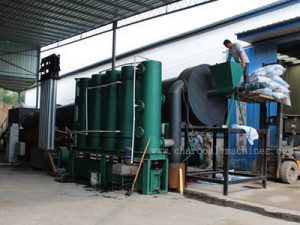Печь непрерывного действия для карбонизации. Когда кокосовая скорлупа карбонизируется, ее необходимо сначала измельчить и раздробить до определенной степени. Степень измельчения определяется в соответствии с потребностями заказчика. Следующий этап — сушка. Сушка также очень важна. Обычно сырье для карбонизации сушат перед карбонизацией, иначе эффект карбонизации будет плохим. Степень сушки кокосовой скорлупы — содержание воды около 15–20%. Не следует пересушивать. После сушки происходит карбонизация. Это также очень важно. Если карбонизация пройдет не должным образом, материал может быть испорчен, превратиться в золу или не обуглиться. В этот момент очень важно использовать печь для карбонизации. Как ею управлять? Есть несколько моментов, на которые следует обратить внимание.
1 Подачу материала следует осуществлять в соответствии с входным отверстием карбонизационной машины. При падении материала включайте и выключайте машину для подачи, чтобы пополнить карбонизированный материал. Материал в нижнем загрузочном отверстии не должен накапливаться. Рекомендуется, чтобы материал в карбонизационной трубе составлял около 2/3.
2 Скорость карбонизационной машины следует регулировать в зависимости от эффекта карбонизации, а скорость вращения шпинделя следует соответствующим образом регулировать для обеспечения выхода угля. (Скорость вращения шпинделя можно регулировать)
3 Когда из уплотнительной сальниковой гайки на обоих концах вращающегося вала выходит дым, болты уплотнительной сальниковой гайки следует затянуть вовремя после смены, а при необходимости заменить асбестовую набивку уплотнительного материала.


Зная, как управлять, следующим шагом является контроль температуры. Горелка горелки распыляет, карбонизационная труба нагревается, термопара вставлена в корпус печи, а пространство внутри печи отображается на приборе контроля температуры на панели шкафа управления через провод. (Фактическая температура внутри карбонизационной трубы будет на 200–300° выше измеренной температуры в печи.) Экологически чистое оборудование для карбонизации, нагревается в печи в течение 15–20 минут. Когда температура достигнет 550–600 градусов, нажмите пусковую кнопку загрузочной машины, шнек в шнековой машине вращается, и машина для подачи начинает подавать материал. Карбонизированный материал скорлупы будет вращаться вместе со спиралью шнековой машины. Трубчатый корпус поднимает материал к загрузочному отверстию над карбонизационной машиной.
Когда материал из кокосовой скорлупы заполняет вход carbonization машины, нажмите кнопку запуска печи карбонизации, переведите красный переключатель на электромагнитном регуляторе в положение ВКЛ, и медленно поверните ручку управления скоростью, чтобы указатель регулятора показал отклонение, указывая на примерно 500-600 об/мин (подходит для кокосовой скорлупы). Шнек карбонизационной машины вращается по спирали, продвигая материал вперед, перемешивая и перемещая его, в первых и вторых трубах карбонизации сверху и снизу. Предварительная сушка, вода в осадке отводится через выпускную трубу. Дымовая труба выбрасывает в воздух, а материал находится в трубе. Когда одна или две трубы высушены и переходят в третью трубу, вода уже осела и очищена. На этапе низкотемпературной карбонизации, после непрерывного продвижения, движения и перемешивания, при входе в четвертую трубу материал поворачивается, перемешивается, продвигается и перемещается на расстояние в высокотемпературном корпусе трубы, чтобы завершить карбонизацию от низкой температуры до высокой. В процессе превращения углерода высокотемпературный углерод, полученный в итоге, в конечном итоге выводится из разгрузочного отверстия карбонизационной машины в вход охладительной и разгрузочной машины типа водяной рубашки, и высокотемпературный углеродный порошок разгрузочной машины охлаждается и остывает с помощью охлаждающей воды, окружающей корпус трубы, и в конечном итоге выводится из разгрузочного отверстия машины. Тонер и сажа после охлаждения, как описано ранее, снова и снова, непрерывно работают, чтобы завершить весь процесс карбонизации продуктов из кокосовой скорлупы.
